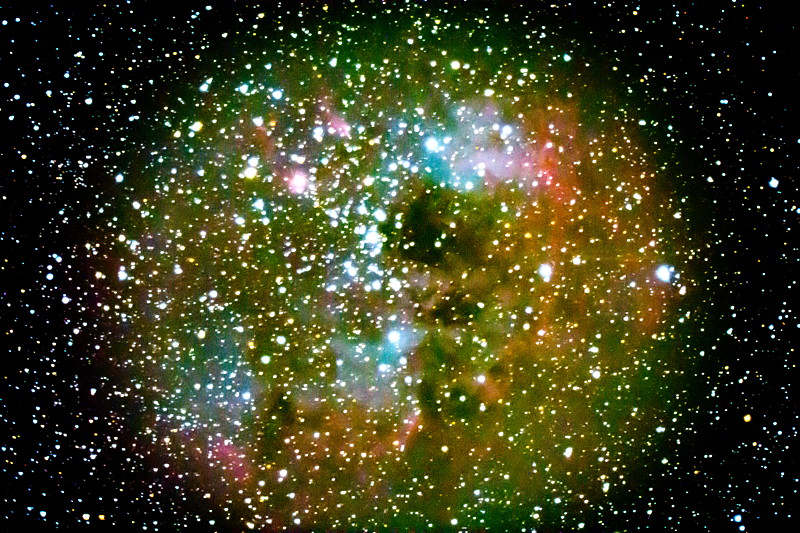DSLR Imaging: M78, NGC1977, and IC410 Nebulae
Posted: 2 April 2016
Clouds prevented observing from Monday, 28 March 2016, through Thursday, 31 March. Lost good ISS imaging opportunities Tuesday and Wednesday nights due to clouds. The sky finally cleared on Friday, 1 April.
From the GOOD NEWS DEPARTMENT: The PZT Hardware Kit arrived on Thursday, 31 March:

I plan to complete the PZT soon.
And more from the GOOD NEWS DEPARTMENT: the pier shipped on Friday, 1 April. No fooling.
|
Open: Friday, 1 April 2016, 1817 MST Temperature: 84°F |
Session: 944 Conditions: Partly cloudy |
I used the wired AutoStar II this night with the newly received ScopeStuff AutoStar II Cable, which is longer than the Meade supplied cable. I will be posting a review of the ScopeStuff cable soon. 1832 MST: StarLock OFF. GOTO Sirius and measured the field-of-view with the William Optics Binoviewers. It was 26' 05".
I then updated the TLE for the night's pass of the International Space Station (ISS). 1847 MST: sunset. The sky was now mostly clear. Prepared the D7200 DSLR for imaging at prime focus + 2X PowerMate. Checked the finderscope alignment; good. Did a focus test on Sirius using the Astrozap mask. 1858 MST: was ready for the ISS pass to begin at 1915 MST. The sky would still be bright and the ISS would rise behind a tree. The initial telescope pointing was off a few degrees when the pass started. Once I located the ISS in the western sky and got it centered in the finderscope it was already rather high in the sky. Once centered tracking was pretty good, at least until the ISS approached the North Celestial Pole, where it went berserk (as the AutoStar usually does when doing satellite tracking near the pole with the telescope polar mounted). I never was able to re-acquire the ISS in the finderscope after about mid-pass. During post-processing of the HD video recording I discovered that the camera had shifted and changed the focus, blurring out the ISS. Rats.
1930 MST: viewed Jupiter, 102X. Four moons visible. Seeing was not good. I powered on the GC Wi-Fi Adapter and did some beta testing of a new version of ScopeBoss using my new iPad Pro 9.7". I will update my ScopeBoss review once the new version is released.
1944 MST: Prepared the DSLR for Deep Sky Object imaging. Mounted the camera at prime focus + Optec Focal Reducer. Used Betelgeuse as the focus test star. SYNCed the AutoStar on Betelgeuse. 1957 MST: Zodiacal Light was shining brightly in the western sky. Turned the StarLock ON. Let it do an Automatic Rate Calibration, which resulted in guiding percentages of RA 43% and Dec 25%. GOTO M78. The nebula was visible in the DSLR viewfinder. After imaging M78, I imaged NGC1977 (Running Man Nebula), followed by IC410, all using the focal reducer. StarLock guiding was not perfect, but should improve once I have the telescope on the pier and do some final adjustments. Here are the results of this night's imaging, all full-frame images:
M78, 5 minutes, ISO 4000, White Balance 4000K

NGC1977 (Running Man Nebula), 2 minutes, ISO 4000, White Balance 4000K

IC410, 5 minutes, ISO 6400, White Balance 4000K

Some vignetting is visible in the last image as the image was highly processed.
2056 MST: ended DSO imaging. I could have done more imaging this night but wanted to keep the session short to rest up for PZT work the next day. 2104 MST: quick look at Jupiter, 102X.
|
Close: Friday, 1 April 2016, 2116 MST Temperature: 53°F |
Session Length: 2h 59m Conditions: Clear |
I have posted photos of slide rules that I used back in the 1960s and 1970s, as well as some other items of a mathematical nature.
Comments are welcome using Email. Twitter users can use the button below to tweet this report to your followers. Thanks.
Cassiopeia Observatory Home Page
Copyright ©2016 Michael L. Weasner / mweasner@me.com
URL = http://www.weasner.com/co/Reports/2016/04/02/index.html
